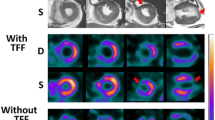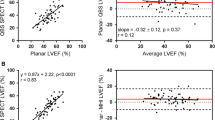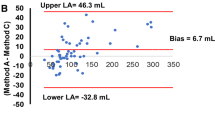Abstract
Purpose
CZT technology allows ultrafast low-dose myocardial scintigraphy but its accuracy in assessing left ventricular function is still to be defined.
Methods
The study group comprised 55 patients (23 women, mean age 63 ± 9 years) referred for myocardial perfusion scintigraphy. The patients were studied at rest using a CZT camera (Discovery NM530c; GE Healthcare) and a low-dose 99mTc-tetrofosmin clinical protocol (mean dose 264 ± 38 MBq). Gated SPECT imaging was performed as a 6-min list-mode acquisition, 15 min after radiotracer injection. Images were reformatted (8-frame to 16-frame) using Lister software on a Xeleris workstation (GE Healthcare) and then reconstructed with a dedicated iterative algorithm. Analysis was performed using Quantitative Gated SPECT (QGS) software. Within 2 weeks patients underwent cardiac magnetic resonance imaging (cMRI, 1.5-T unit CVi; GE Healthcare) using a 30-frame acquisition protocol and dedicated software for analysis (MASS 6.1; Medis).
Results
The ventricular volumes obtained with 8-frame QGS showed excellent correlations with the cMRI volumes (end-diastolic volume (EDV), r = 0.90; end-systolic volume (ESV), r = 0.94; p < 0.001). However, QGS significantly underestimated the ventricular volumes (mean differences: EDV, −39.5 ± 29 mL; ESV, −15.4 ± 22 mL; p < 0.001). Similarly, the ventricular volumes obtained with 16-frame QGS showed an excellent correlations with the cMRI volumes (EDV, r = 0.92; ESV, r = 0.95; p < 0.001) but with significant underestimations (mean differences: EDV, −33.2 ± 26 mL; ESV, −17.9 ± 20 mL; p < 0.001). Despite significantly lower values (47.9 ± 16 % vs. 51.2 ± 15 %, p < 0.008), 8-frame QGS mean ejection fraction (EF) was closely correlated with the cMRI values (r = 0.84, p < 0.001). The mean EF with 16-frame QGS showed the best correlation with the cMRI values (r = 0.91, p < 0.001) and was similar to the mean cMRI value (49.6 ± 16 %, p not significant). Regional analysis showed a good correlation between both 8-frame and 16-frame QGS and cMRI wall motion score indexes (8-frame WMSI, r = 0.85; 16-frame WMSI, r = 0.89; p < 0.01).
Conclusion
Low-dose gated SPECT with a CZT camera provides ventricular volumes that correlate well with cMRI results despite significant underestimation in the measure values. EF estimation appeared to be more accurate with 16-frame reformatted images than with 8-frame images.




Similar content being viewed by others
References
Garcia EV, Faber TL, Esteves FP. Cardiac dedicated ultrafast SPECT cameras: new designs and clinical implications. J Nucl Med. 2011;52:210–7.
Esteves FP, Raggi P, Folks RD, Keidar Z, Askew JW, Rispler S, et al. Novel solid-state-detector dedicated cardiac camera for fast myocardial perfusion imaging: multicenter comparison with standard dual detector cameras. J Nucl Cardiol. 2009;16:927–34.
Duvall WL, Croft LB, Ginsberg ES, Einstein AJ, Guma KA, George T, et al. Reduced isotope dose and imaging time with a high-efficiency CZT SPECT camera. J Nucl Cardiol. 2011;18:847–57.
Gimelli A, Bottai M, Genovesi D, Giorgetti A, Di Martino F, Marzullo P. High diagnostic accuracy of low-dose gated-SPECT with solid-state ultrafast detectors: preliminary clinical results. Eur J Nucl Med Mol Imaging. 2012;39(1):83–90.
Giorgetti A, Genovesi D, Marzullo P. Nuclear cardiology at the door of a new era: better to save mSv or to reduce imaging time? Eur J Nucl Med Mol Imaging. 2012;39(12):1898–900.
Germano G, Erel J, Lewin H, Kavanagh PB, Berman DS. Automatic quantitation of regional myocardial wall motion and thickening from gated technetium-99m sestamibi myocardial perfusion single-photon emission computed tomography. J Am Coll Cardiol. 1997;30(5):1360–7.
Bland JM, Altman DG. Statistical methods for assessing agreement between two methods of clinical assessment. Lancet. 1986;1:307–10.
Hammermeister KE, de Rouen TA, Dodge HT. Variables predictive of survival in patients with coronary disease. Selection by univariate and multivariate analyses from the clinical, electrocardiographic, exercise, arteriographic, and quantitative angiographic evaluations. Circulation. 1979;59:421–30.
Grover S, Leong DL, Selvanayagam JB. Evaluation of left ventricular function using cardiac magnetic resonance imaging. J Nucl Cardiol. 2011;18:351–65.
Nakajima K, Higuchi T, Taki J, Kawano M, Tonami N. Accuracy of ventricular volume and ejection fraction measured by gated myocardial SPECT: comparison of 4 software programs. J Nucl Med. 2001;42:1571–8.
Bavelaar-Croon CDL, Kayser HWM, van der Wall EE, de Roos A, Dibbets-Schneider P, Pauwels EK, et al. Left ventricular function: correlation of quantitative gated SPECT and MR imaging over a wide range of values. Radiology. 2000;217:572–5.
Bax JJ, Lamb H, Dibbets P, Pelikan H, Boersma E, Viergever EP, et al. Comparison of gated single-photon emission computed tomography with magnetic resonance imaging for evaluation of left ventricular function in ischemic cardiomyopathy. Am J Cardiol. 2000;86:1299–305.
Faber TL, Vansant JP, Pettigrew RI, Galt JR, Blais M, Chatzimavroudis G, et al. Evaluation of left ventricular endocardial volumes and ejection fractions computed from gated perfusion SPECT with magnetic imaging: comparison of two methods. J Nucl Cardiol. 2001;8:645–51.
Vaduganathan P, He Z, Vick III GW, Mahmarian JJ, Verani MS. Evaluation of left ventricular wall motion, volumes, and ejection fraction by gated myocardial tomography with technetium 99m-labeled tetrofosmin: a comparison with cine magnetic resonance imaging. J Nucl Cardiol. 1998;6:3–10.
Lipke CSA, Kühl HP, Nowak B, Kaiser HJ, Reinartz P, Buell U, et al. Validation of 4D-MSPECT and QGS for quantification of left ventricular volumes and ejection fraction from gated Tc-MIBI SPET: comparison with cardiac magnetic resonance imaging. Eur J Nucl Med Mol Imaging. 2004;31:482–90.
Nakajima K, Taki J, Higuchi T, Kawano M, Taniguchi M, Maruhashi K, et al. Gated SPET quantification of small hearts: mathematical simulation and clinical application. Eur J Nucl Med. 2000;27:1372–9.
Sharir T, Kang X, Germano G, Bax JJ, Shaw LJ, Gransar H, et al. Prognostic value of poststress left ventricular volume and ejection fraction by gated myocardial perfusion SPECT in women and men: gender-related differences in normal limits and outcomes. J Nucl Cardiol. 2006;13:495–506.
Peace RA, Adams PC, Lloyd JJ. Effect of sex, age, and weight on ejection fraction and end-systolic volume reference limits in gated myocardial perfusion SPECT. J Nucl Cardiol. 2008;15:86–93.
Tadamura E, Kudoh T, Motooka M, Inubushi M, Shirakawa S, Hattori N, et al. Assessment of regional and global left ventricular function by reinjection Tl-201 and rest Tc-99m sestamibi ECG-gated SPECT: comparison with three-dimensional magnetic resonance imaging. J Am Coll Cardiol. 1999;33:991–7.
Cochet H, Bullier E, Gerbaud E, Durieux M, Godbert Y, Lederlin M, et al. Absolute quantification of left ventricular global and regional function at nuclear MPI using ultrafast CZT SPECT: initial validation versus cardiac MR. J Nucl Med. 2013;54(4):556–63.
Conflicts of interest
None.
Author information
Authors and Affiliations
Corresponding author
Rights and permissions
About this article
Cite this article
Giorgetti, A., Masci, P.G., Marras, G. et al. Gated SPECT evaluation of left ventricular function using a CZT camera and a fast low-dose clinical protocol: comparison to cardiac magnetic resonance imaging. Eur J Nucl Med Mol Imaging 40, 1869–1875 (2013). https://doi.org/10.1007/s00259-013-2505-9
Received:
Accepted:
Published:
Issue Date:
DOI: https://doi.org/10.1007/s00259-013-2505-9




